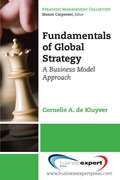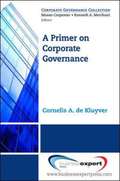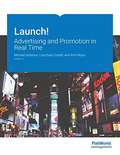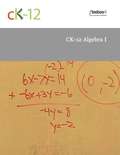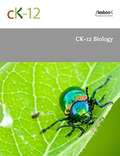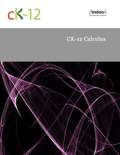Special Collections
Free Upskilling Books for All!
- Table View
- List View
Fundamentals of Global Strategy
by Cornelis A. de KluyverThis book looks at the opportunities and risks associated with staking out a global competitive presence and introduces the fundamentals of global strategic thinking. We define crafting a global strategy in terms of change: how a company should change and adapt its core (domestic) business model to achieve a competitive advantage as it expands globally. The conceptual framework behind this definition has three fundamental building blocks: a company's core business model, the various strategic decisions a company needs to make as it globalizes its operations, and a range of globalization strategies for creating a global competitive advantage. A business model is defined in terms of four principal components: (a) market participation--who its customers are, how it reaches them and relates to them; (b) the value proposition--what a company offers its customers; (c) the supply chain infrastructure--with what resources, activities and partners it creates its offerings; and finally, (d) its management model--how it organizes and coordinates its operations. Globalization requires a company to make strategic decisions about each component of the business model. Market participation decisions include choosing which specific markets or segments to serve, domestically or abroad; what methods of distribution to use to reach target customers; and how to promote and advertise the value proposition. Globalization decisions about the value proposition touch the full range of tangible and intangible benefits a company provides to its customers (stakeholders). Decisions about a company's value chain infrastructure deal with such questions as, What key internal resources and capabilities has the company created to support the chosen value proposition and target markets? What partner network has it assembled to support the business model? How are these activities organized into an overall, coherent value creation and delivery model? Finally, strategic decisions about the global management dimension are concerned with a company's choices about a suitable global organizational structure and decision-making process. We use Pankaj Ghemawat's well-known "AAA Triangle" framework to define three generic approaches to global value creation. Adaptation strategies seek to increase revenues and market share by tailoring one or more components of a company's business model to suit local requirements or preferences. Aggregation strategies focus on achieving economies of scale or scope by creating regional or global efficiencies; they typically involve standardizing a significant portion of the value proposition and grouping together development and production processes. Arbitrage is about exploiting economic or other differences between national or regional markets, usually by locating separate parts of the supply chain in different places.
A Primer on Corporate Governance
by Cornelis A. de KluyverThis book is a primer on corporate governance--the system that defines the distribution of rights and responsibilities among different participants in the corporation, such as the board, managers, shareholders, and other stakeholders, and spells out the rules and procedures for making decisions on corporate affairs. Corporate governance also deals with how a company's objectives are set and the means of attaining those objectives and monitoring performance. The importance of this subject can hardly be overstated. As recent corporate scandals have shown and the current financial crisis reminds us, the efficacy of corporate decision making and our regulatory systems directly affect our well-being. Sound corporate governance not only pays by producing value for all stakeholders of the firm but also, even more importantly, it is the right thing to do--for investors, other stakeholders, and society at large. In other words, sound corporate governance is also a moral imperative. This book is designed to help you become a more effective participant in the corporate governance system--as an executive dealing with a board, as a director, or as a representative of a company's other numerous stakeholders. The book contains two major parts, an epilogue, and appendices. The first part looks at corporate governance from a macro perspective. It describes the U.S. corporate governance system and its principal actors and briefly surveys the history of U.S. corporate governance, including the wave of governance scandals that occurred around the turn of the century. The second part focuses on the board itself and its principal challenges: CEO selection and succession planning, the board's responsibilities in the areas of oversight, compliance and risk management, the board's role in strategy development, the issue of CEO performance appraisal and executive compensation, a board's challenges in dealing with unexpected events and crises, and finally, a board's most difficult challenge--managing itself. The epilogue briefly looks into the future and deals with subjects that are just beginning to appear on boardroom agendas. It assesses the emerging global convergence of governance systems, requirements, and practices; it looks at the prospects of further U.S. governance reform; and it discusses the changing relationship between business and society and its likely impact in the boardroom.
Launch! Advertising and Promotion in Real Time
by Michael Solomon and Lisa Duke Cornell and Amit NizanLaunch! is written for advertising and promotions courses taught to students in the business school and journalism & mass communication students. This book is the first of its kind to teach advertising concepts by reverse engineering a real advertising campaign from beginning to end. In April 2007, SS+K, an innovative New York City communications agency, launched the first ever branding campaign for msnbc.com with the tag "A Fuller Spectrum of News." Launch! follows that campaign from initial agency pitch through roll-out of print and media assets to post-campaign analysis. Throughout, it exposes readers to the theory and concepts of advertising and promotion, and the personalities and decisions that drove this campaign. The book takes a rare look "behind the curtain" - even letting you see some of the paths not chosen by the agency and client. Students get a realistic sense of how theory plays out in practice. They get a flavor for the exciting field of advertising. And, they consistently learn the perspectives of both the advertising agency (where many journalism and communications students will work) and the client (where many marketing majors will work). This is a unique book, with a unique perspective, by a unique author team, and you won't find this kind of insight in any other text on the market.
Project Management from Simple to Complex
by Russell Darnall and John M. PrestonIn a world that is becoming more virtual, more global, and more complex, the project manager's ability to function in this environment becomes critical to the success of the project. Project Management from Simple to Complex explores project management within this complex, virtual, and global environment. This is not a standard textbook that was adapted to the new publishing paradigm but was designed from the beginning to utilize its capabilities. The book is written in collaboration by an expert in Project Management--Russell Darnall--and an expert in writing instructional texts and using technology for communicating online--John Preston--to create a unique learning environment that prepares students to manage projects in a global, multicultural, and online environment.
Human Relations
by Laura Portolese DiasHuman Relations by Laura Portolese-Dias addresses all of the critical topics to obtain career success as they relate to professional relationships. Knowing how to get along with others, resolve workplace conflict, manage relationships, communicate well, and make good decisions are all critical skills all students need to succeed in career and in life. Human Relations book isn't an organizational behavior text, but it provides a good baseline of issues students will deal with in their careers on a day-to-day basis. This book is also not a professional communications book, business English, or professionalism book, as the focus is much broader--on general career success and how to effectively maneuver in the workplace.
Human Resource Management
by Laura Portolese DiasHuman Resource Management by Laura Portolese Dias teaches HRM strategies and theories that any manager--not just those in HR--needs to know about recruiting, selecting, training, and compensating people. Most students will be managing people at some point in their careers and not necessarily in a human resource management capacity. As businesses cut back, they may outsource HR duties to outside vendors. Or, in smaller businesses, the HR department is sometimes small or non-existent, and managers from other departments have to perform their own HRM. Therefore, teaching HRM from the perspective of a general manager, in addition to an HR manager, provides more relevance to students' careers and will give them a competitive advantage in the workplace.
A Primer on Sustainable Business
by Nancy E. Landrum and Sandra EdwardsSustainable (and green) business seems to have become mainstream practically overnight. This growth in interest in sustainable business practices stems from changing societal expectations and a growing awareness that sustainability creates a win-win situation for the business and humanity alike. A Primer on Sustainable Business is a brief introduction to sustainability as it applies to business. This book will offer an overview of how sustainability is applied throughout the organization. We offer chapters organized by familiar departments or functions of the business and cover the applications and terminology of sustainability throughout each area. Whether you are an executive, an entrepreneur, an employee, or a business student, this book will help you understand the big picture of what it means to be a sustainable business and will give you the information you need to begin your journey toward sustainability.
Exploring Perspectives
by Randall FallowsThis 5 chapter primer will help give students a better understanding of how to discover, develop, and revise an analytical essay for their argument and persuasion courses.
CK-12 Advanced Probability and Statistics
by Ck-12 FoundationCK-12 Foundation's Advanced Probability and Statistics FlexBook covers the following chapters: An Introduction to Analyzing Statistical Data - Students learn definitions of statistical terminology, and review data, measures of center, and measures of spread. Visualizations of Data - histograms and frequency distributions, common graphs and data plots, and box-and-whisker plots. An Introduction to Probability - events, sample spaces, probability, compound events, the complement of an event, conditional probability, and basic counting rules. Discrete Probability Distribution - random variables, probability distribution for a discrete random variable, mean and standard deviation of discrete random variables and the Binomial Probability Distribution. Normal Distribution - standard normal probability distribution, the density curve of the normal distribution, and applications of the normal distribution. Planning and Conducting an Experiment or Study - surveys, sampling and experimental design. Sampling Distributions and Estimations - sampling distributions and the Central Limit Theorem. Hypothesis Testing - The P-value, testing a proportion hypothesis, testing a mean hypothesis, and testing a hypothesis for dependent and independent samples. Regression and Correlation - scatterplots and linear correlation, Least-Squares regression, inferences about regression, and an introduction to multiple regression. Chi-Square- the Goodness-of-Fit test, test of independence, and testing one variance. Analysis of Variance and the F-Distribution - the F-Distribution and testing two variances, the One-Way ANOVA test, and the Two-Way ANOVA test. Non Parametric Statistics - nonparametric statistics, the rank sum test and rank Correlation, and the Kruskal-Wallis test.
CK-12 Advanced Probability and Statistics Second Edition Volume 1
by Ck-12 FoundationAn open source textbook.
CK-12 Advanced Probability and Statistics Second Edition Volume 2
by Ck-12 FoundationAn open source textbook.
CK-12 Algebra 1 Second Edition Volume 1
by Ck-12 FoundationAn open source textbook: algebra 1, 2nd edition, volume 1.
CK-12 Algebra 1 Second Edition Volume 2
by Ck-12 FoundationAn open source textbook: algebra 1, 2nd edition, volume 2.
CK-12 Algebra I
by Ck-12 FoundationCK-12 Foundation's Algebra FlexBook is an introduction to algebraic concepts for the high school student. Topics include: Equations & Functions, Real Numbers, Equations of Lines, Solving Systems of Equations & Quadratic Equations.
CK-12 Biology I - Honors
by Ck-12 FoundationCK-12 Foundation's Biology 1- Honors FlexBook Covers the following chapters:
Foundations of Life Science- scientific investigations, methods, observations, & communication.
Chemical Basis of Life- matter, the significance of carbon, lipids, proteins.
Cell Structure and Function- prokaryotic, eukaryotic, plant, & animal cell features; structures / functions of DNA, RNA, protein, cell transport, homeostasis.
Photosynthesis- water, carbon, and nitrogen cycle between abiotic and biotic resources.
Cellular Respiration- relation to glycolysis, Krebs Cycle, electron transport chain.
Cell Division and Reproduction- cell division, reproduction.
Mendelian Genetics- inheritance, sex-linked traits.
Molecular Genetics- DNA, RNA, protein synthesis, mutation, regulating gene expression.
Human Genetics- human genome, diseases, Biotechnology- DNA technology, gene cloning.
History of Life- evolution, macroevolution, extinctions, episodic speciation, response to change.
Evolutionary Theory- Darwin's Theory of Evolution, common ancestry and natural selection.
Evolution in Populations- genetics of populations, genetic diseases, natural selection.
Classification- Taxonomy, scientific classification of organisms.
Principles of Ecology- Ecology's relation with energy; ecosystems, the water, carbon, and nitrogen cycles.
Biomes, Ecosystems and Communities- terrestrial/ aquatic biomes, community interactions.
Populations- Analysis of populations and dynamics.
Ecology and Human Actions- Balance between humans and the earth addressing natural resources, ecosystems, & biodiversity.
The Human Body- systems.
Nervous and Endocrine Systems- structures & functions, homeostasis.
Skeletal, Muscular, and Integumentary Systems- structures, functions, & homeostasis.
Circulatory and Respiratory Systems- structures and functions.
Digestive and Excretory Systems- structures/ functions, food pyramid.
Immune System and Disease- Body defenses against pathogens.
Reproductive System and Human Development- human reproductive systems, reproductive lifecycle, STDs.
CK-12 Biology I (with image descriptions)
by Ck-12 FoundationOpen source biology textbook from CK-12.
CK-12 Calculus
by Ck-12 FoundationCK-12 Foundation's Single Variable Calculus FlexBook covers the following chapters: Functions, Limits, and Continuity - A review of the basics of functions is given. Students use linear approximations to study the limit process, before a more formal treatment of limits is given. Differentiation - Students explore instantaneous rate of change, and the relationship between continuity and differentiability. The Chain Rule and implicit differentiation are reviewed. Applications of Derivatives - Students gain practice with using the derivatives in related rates problems. Additional topics include The First Derivative Test, The Second Derivative Test, limits at infinity, optimization, and approximation errors. Integration - This chapter includes indefinite integrals calculus, initial value problems, definite integrals, the Fundamental Theorem of Calculus, integration by substitution, and numerical integration. Applications of Integration - This chapter includes applications of the definite integral, such as calculating areas between two curves, volumes, length of curves, and other real-world applications in physics and statistics. Transcendental Functions - This chapter includes differentiation and integration of logarithmic and exponential functions, exponential growth and decay, derivatives and integrals involving inverse trigonometric functions, and L'Hospital's Rule. Integration Techniques - Students explore integration by substitution, integration by parts, integration by partial fractions, trigonometric integrals, trigonometric substitutions, and improper integrals. Infinite Series - This chapter introduces the study of sequences and infinite series. The properties presented describe the behavior of a sequence or series, including whether a sequence approaches a number or an infinite series adds to a number.
